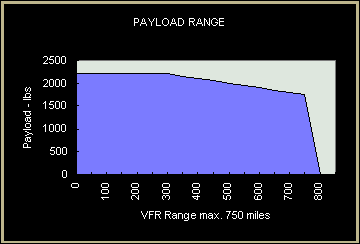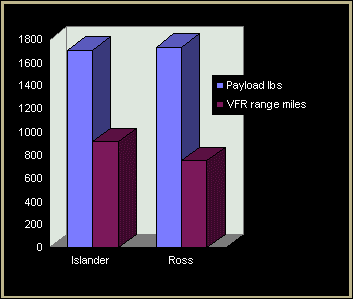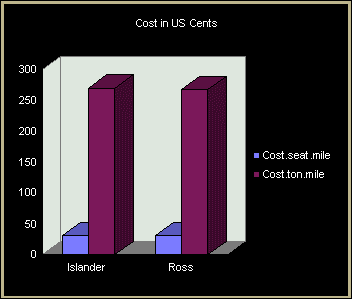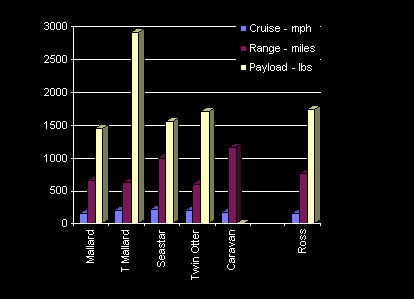

The specification, operating cost and competitive advantage of the new amphibian are enhanced by innovative financing ownership packages to provide the operator with opportunities to maximise profits on even the most demanding routes.
For operational profitability, the performance and operating cost specifications of the Ross amphibian must be comparable to currently available commercial seaplanes, and favourably equivalent to land based aircraft of similar design and capacity.
The base airframe chosen for amphibian conversion is Europe's best selling twin engined aircraft; the Pilatus Britten Norman BN2B Islander, with over 1200 sold world wide in a production run exceeding 30 years.
The Islander is adaptable, versatile and durable, with an unsurpassed record of solving transportation problems simply and economically in some of the world's harshest environments. The aircraft combines ruggedness of construction and low maintenance, with minimum cost operation and exceptional levels of utility.
Key design modifications to the base airframe include;
- the attachment of an amphibious glove to the fuselage,
- raising the existing engine thrust linesinstallation of wing floats, and,
- converting from fixed tricycle to retractable conventional undercarriage.
- To provide a twin engined commercial amphibian for seaplane operators at a purchase price and hourly operating cost, competitive with equivalent specification land based aircraft and the existing maritime aircraft fleet.
- To build upon the sales and operational success of the Britten Norman Islander by offering increased operational with the ability to operate from land and water.
The hull (amphibious glove) is manufactured from high strength aluminium alloy sheet, built up and pressed bulkheads and angle shaped sheet members, joined by conventional riveted construction. All seams and joints sealed prior to and after assembly, corner fillers used to seal exposed and water tight bulkhead joints. The hull is assembled, sealed, chemically treated for anti corrosion required for operation in salt water, water tested and attached to the primed and corrosion treated Islander fuselage by joining angles.
A 20 degree dead rise at the step carries forward to station 99, then increases sharply to 51 degrees at the bow. This treatment permits the hull to cut through steep chop and associated with the low landing speed, considerably reduces bottom loading's along the hull. Chines are heavier than structurally required to withstand docking and day to day operational use. Drain plugs are provided at the low point of each water tight compartment and a sufficient number of bulkhead sections have been provided to insure flotation in the event of one compartment being holed and flooded.
Buoyancy, including wing floats, provides for 8,000 lb gross weight at the low water line (LWL). Due to the narrow beam hull, displacement is approximately 24 inches at the step placing the LWL some 4" below the sill of the port aft door. Split doors are fitted, (Grumman design practice), with sealed doors to provide safe, non water intrusive, in sea operations. Mooring cleats are located at the forward and aft port doors for attaching docking lines.
The undercarriage mounting and landing gear is a retractable conventional landing gear design as specified for the Ross amphibian conversion. The main landing gear attachment and hydraulic operation are located in the glove area, with the main gear retracted into an external faring. Main gear landing loads (vertical, horizontal and lateral) are carried into the hull and taken directly into two main frames running into the wing support area, relieving considerable demands formerly placed upon, the main gear vertical strut, the nacelle, landing gear pickup structure, and, the wing / landing gear attachment fittings. The undercarriage components from the Schweizer Agcat aircraft are a well proven system suitable for this conversion.
The standard amphibian utilises the BN2B wing in the new configuration, allowing an increase in gross weight capability to 7,380 Ibs. The wing has a span of 49 feet with an 80 inch chord giving a wing area is 325 sq ft and an aspect ratio of 6.63. Standard fuel bays are retained at 130 USG with provision for an additional 85 USG at customer request.
PERFORMANCE AND COST
COMPARISON
| Specification
The operating specification for the production amphibian is based on the standard BN2B Islander wing at a gross weight of 7,380 Ibs. The payload analysis (single pilot operation) assumes weight of pilot at 1871bs (JAR Ops: proposal), passengers at 170 Ibs plus 15 Ibs of hand baggage, and individual passenger interline baggage of 40 Ibs. The max fuel case provides seven paying seats while the max payload case provides for full nine paying seats. |
|
|||||||||||||||||||||||||||||||||||||||||||||||||
| The payload performance of the Ross amphibian is amply displayed in the payload range graph which demonstrates a carrying capacity of ¾ of a ton over 750 miles or a short range capability of a ton over 300 miles. |
The next graph
compares the payload and range performance of the Pilatus
Britten Norman BN2B-26 Islander to the RAC amphibian
derivative.
It clearly demonstrates that the amphibian payload performance exceeds that of the standard Islander, whilst range is reduced by only 18%.The amphibian payload capability translates into cost effective per seat per mile and cost per ton per mile operating figures. (EXHIBIT A)
An estimate of the fixed
and variable operating costs were made and applied
consistently to the Islander and amphibian. The fixed
costs included estimates for interest rate, insurance,
maintenance and hangarage which will vary according to
individual operator circumstances, however, the same
criteria have been applied to both aircraft for
comparison purposes.
Variable cost was calculated assuming 1,000 hours annual utilisation and includes airframe and engine leasing costs, maintenance, fuel, oil and contract pilot. (EXHIBIT B)
With full fuel, the Islander costs 41 cents per seat per mile, or $3.45 per ton per mile to operate. At full payload the operating cost reduces to 31 cents per seat per mile and $2.94 per ton per mile.
The Ross amphibian achieves or betters these figures on a like for like basis and can boast operating costs of as little as 31 cents per seat per mile and $2.67 per ton per mile. A typical 250 mile flight would be $75 per seat or $667 per ton.
In terms of performance, operating and capital costs the Ross amphibian compares favourably with the existing world fleet of marine aircraft.
The competitive analysis was completed by comparing the maximum fuel payload, cruise speed and range of the Grumman G73 Mallard, DeHavilland Twin Otter, Dornier Seastar and the Cessna C208 Caravan. All aircraft except the G73 Mallard are powered by turbine engines and for comparison purposes a third party Turbine converted Mallard was included in the analysis. All aircraft except the Caravan are twin engined and the only new aircraft, other than the Ross amphibian, is the Dornier Seastar.
The graph highlights an unusual design feature of the Cessna Caravan to good effect. The maximum design fuel load for the aircraft exceeds its payload, hence the zero load capability at full fuel weight.
The payloads were reduced on the Twin Otter and Caravan by the weight of the third party amphibious floats fitted to the aircraft. The weight of the floats, plus fitting kits were estimated at 1,500 Ibs.
The estimated capital cost to a business acquiring the listed aircraft are derived from published reports or are best estimates. In all cases, other than the Seastar, the prices represent market price for the second hand aircraft.
To put the prices into perspective, the quoted price for a set of Wipaire amphibious floats fitted to a Twin Otter or Cessna Caravan are US$1,250,000. The ex factory list price for a new Ross amphibian is US$850,000 (June 1997).
All information contained in this document is believed to be correct at the time of printing (June 1997).
23 Oct 1998




